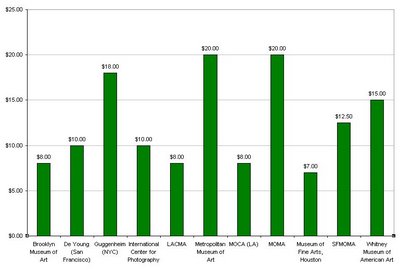Is Modern Art Going the Way of the Symphony? Met Raises Admission Fee To Become One Of Nation's Most Expensive Art Museums
Sometimes art forms that should have mass appeal are unduly restricted by high participation costs, and resist attempts at democratization, becoming increasingly irrelevant due to the cost of maintaining the institution. The concert symphony in America is a good example of this; huge public projects spend taxpayer money to fund an art form that must then support itself with high fees that most of the citizenry cannot afford to pay on a regular basis.
Visual art is threatened by just such a dynamic when museum admission fees get too high; the person on the street is discouraged from entering, or prevented outright, because they cannot contribute significantly enough to support their "share" of the massive costs associated with running the institution. In the case of art museums it is particularly sad because budget shortfalls are the product not only of the rising values of risk-free, gold-standard artworks but also of outreach. The effect of this cycle is that flagship museums go to great lengths to subsidize the art education of a generation of students who will grow up and realize they cannot afford to go to art museums.
The New York Times reported a few days ago that the Metropolitan Museum of Art in Manhattan has raised its admission fee from $15 to $20, one in a trend of rising admission fees. MOMA did the same thing two years ago, raising its fee from $12 to $20 in 2004, when it relocated to midtown Manhattan. Unlike MOMA's obligatory fee, however, the Met's is optional, although the museum doesn't advertise that fact. Museum officials declined to provide the Times with statistics regarding how many of the museum's 4.2 million annual visitors pay the full fee. Critics argue that high admission fees, even when optional, discourage marginal art-viewers from visiting museums. The chart above displays the admission fees of some major American art museums; click on it for a larger view. The dataset does not include free museums, such as the Smithsonian in D.C. and the Getty in Los Angeles, and emphasizes the cities I'm familiar with - San Francisco, L.A., and New York. It also does not reflect "special exhibit" fees, which some museums surprise tourists with to inflate revenues. Houston's Museum of Fine Arts, for example, charges a low $7 general admission fee but has frequent exhibits which cost an extra $10 to enter, and which cannot be accessed without paying both fees. The museum occasionally even has two such fee-based exhibits (as it did when I visited once a few years ago), which can drive the total ticket price up to $27. These fees often go undisclosed on museum websites and may cause a chart like mine to unfairly penalize museums who charge only a flat admission fee to all of its offerings. The Times wrote about this phenomenon as well, noting that the Museum of Fine Arts in Boston charges $23 for special exhibits on top of its $15 adult admission fee.
The chart above displays the admission fees of some major American art museums; click on it for a larger view. The dataset does not include free museums, such as the Smithsonian in D.C. and the Getty in Los Angeles, and emphasizes the cities I'm familiar with - San Francisco, L.A., and New York. It also does not reflect "special exhibit" fees, which some museums surprise tourists with to inflate revenues. Houston's Museum of Fine Arts, for example, charges a low $7 general admission fee but has frequent exhibits which cost an extra $10 to enter, and which cannot be accessed without paying both fees. The museum occasionally even has two such fee-based exhibits (as it did when I visited once a few years ago), which can drive the total ticket price up to $27. These fees often go undisclosed on museum websites and may cause a chart like mine to unfairly penalize museums who charge only a flat admission fee to all of its offerings. The Times wrote about this phenomenon as well, noting that the Museum of Fine Arts in Boston charges $23 for special exhibits on top of its $15 adult admission fee.
The next "special exhibit" at MFA Houston is the collection of "French Masterpieces" that the Met is touring specifically to help raise money. It opens in Houston on February 4, 2007.
Thank goodness for galleries.







1 comment:
These high museum admission fees are totally against any museum's mission statement - to provide art for the benefit of the public. Instead of making art accessable, they make it elitist. I don't know how an average family can afford spend an afternoon at a museum and that's a shame.
Post a Comment